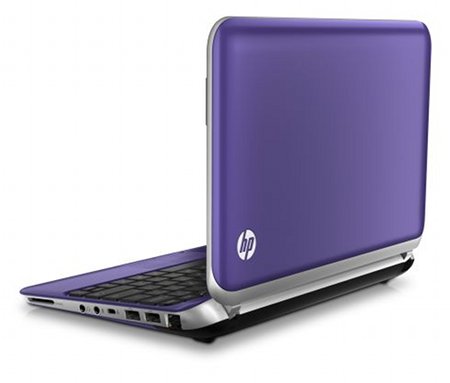More colorful HP netbook gets hi-res option and larger drives, too
May 9, 2011 — by LinuxDevices Staff — from the LinuxDevices Archive — 1 viewsHP announced a revamped version of its Mini 210 netbook that includes upgraded audio plus color that's skin-deep. Still with a choice of Intel Atom processors and Windows 7 operating systems, the device now includes a social-media-centric upgrade to the available, Linux-based QuickWeb operating system, according to the company.
HP's first netbook, the April 2008 Mini-Note 2133, featured a Via C7-M ULV processor, an aluminum shell, and a coated "DuraKeys" keyboard, and was touted as being suitable for business and educational markets. HP later targeted consumers with the Atom N270-based Mini 1000, released in October 2008. A deluge of HP netbooks has followed, each featuring similar technology, but tweaked somewhat to suit consumer, enterprise, or educational markets.
The company's original Mini 210 was released in January 2010 with the usual 10.1-inch, 1024 x 600 pixel screen and an Intel Atom N450 processor. A revamped Mini 210 appeared last September with a wider choice of processors, five different colors, and a new flush-fitting battery.
Now, we have a third generation of the Mini 210. It mostly offers the same old tech, though HP is now offering a 1366 x 768 pixel option for the display, as well as hard drives that start at 250GB and go up to 500GB.

HP's latest Mini 210 revamp
The main fillip here is color: "sweet purple," "charcoal," "crimson red," "luminous rose", or ocean drive. The HP-supplied photo above doesn't do a good job of showing it (go to Liliputing or PC Perspective for more revealing images), but color is, unusually, extended throughout the top of the device, including between its keys.
Liliputing notes that the device's touchpad is now blended in with its overall palm rest area, which "could lead to some awkward swipes." But, the site adds, there are now separate left and right mouse buttons below the touch area, which is "good news."
Styled similarly to the HP Pavilion dm1z we have reviewed favorably, the Mini 210 has a swoopy design that hides its Ethernet port under a flap, plus a bottom panel that un-snaps without tools for memory and hard drive upgrades. Here, however, there's no HDMI port — only a VGA port, three USB 2.0 ports, audio I/O, and an SD slot.
Like the dm1z and various other HP portables, the Mini 210 also features HP's QuickWeb, a version of the Splashtop OS sold by Splashtop Inc. (formerly DeviceVM). This is a Linux-based environment the netbook can boot into relatively quickly, and which provides its own access to web browsing, email, Skype videoconferencing, plus music playback, and photo viewing.
According to HP, the Mini 210 features a new 3.0 version of the QuickWeb that includes a customizable widget dashboard and syncs to Windows bookmarks. Users can chat with friends on Skype, update Facebook posts or tweets, and view their social calendars all in one place, the company adds. Version 3.0 may be the last to appear on HP devices, as the company says it will instead offer a version of its own, Linux-based WebOS operating system on all its Windows PCs starting next year.
The mk. III Mini 210 is also said to include enhanced "Beats Audio" speakers. Other than that, however, the underlying hardware seems to be the same as the previous version, including a choice of three different CPUs: the 1.66GHz Atom N455, the 1.83GHz N475, or the dual-core, 1.5GHz N550, according to HP.
Purchasers of the N475 or N550 versions of the Mini 210 who want an additional speed boost may select an optional Broadcom Crystal HD video accelerator. Thusly equipped, the devices play back 720p and 1080p video from local files or "the most advanced video websites," according to HP.
Specifications listed by HP for its thrice-revised Mini 210 include the following:
- Processor — 1.66GHz Atom N455, 1.83GHz Atom N475, or 1.5GHz, dual-core, Atom N550
- Chipset — Intel NM10, plus optional Broadcom Crystal HD video accelerator
- Memory — 1GB or 2GB of DDR3 RAM
- Display — 10.1-inch screen with 1024 x 600 or 1366 x 768 resolution
- Camera — webcam (resolution n/s)
- Storage — 250GB (5400 or 7200rpm), 320 (5400 or 7200rpm), or 500GB (7200rpm) hard disk drives
- Expansion — SD slot
- Networking:
- LAN — 10/100 Ethernet
- WLAN — 802.11b/g/n
- PAN — Bluetooth (optional)
- WWAN — GSM or CDMA cellular modem (optional)
- Other I/O:
- GPS receiver (optional)
- 3 x USB 2.0
- 1 x VGA
- audio I/O (mic in and headphones out)
- Battery — six-cell, with up to 10.75 hours of operation
- Dimensions — 10.55 x 7.51 x 1.26 inches
- Weight — 3.1 pounds
- Operating system — Windows 7 Starter or Windows 7 Home Premium with QuickWeb (Linux)
Further information
According to HP, the Mini 210 is available in the U.S. now, with prices starting at $329 and $399, respectively. More information may be found on the company's Mini 210 product page.
In addition to the Mini 210, HP also announced larger, enterprise-focused portable computers, including a 12.1-inch laptop whose screen flips around into a tablet configuration, the EliteBook 2760p. eWEEK offers a brief summary.
This article was originally published on LinuxDevices.com and has been donated to the open source community by QuinStreet Inc. Please visit LinuxToday.com for up-to-date news and articles about Linux and open source.